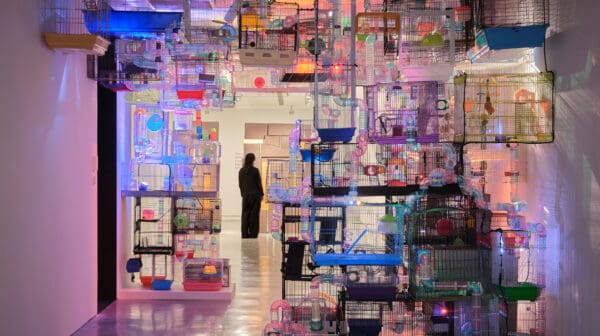
Material curiosities: Primavera 2025
In its 34th year, Primavera—the Museum of Contemporary Art Australia’s annual survey of Australian artists 35 and under—might be about to age out of itself, but with age it seems, comes wisdom and perspective.
Hossein Valamanesh is best known for his installation and sculptural work, but last year he presented his first large-scale video piece, Char Soo, in collaboration with his filmmaker son Nassiem Valamanesh. Char Soo, means four sides and is a four-screen projection which transports the viewer to the middle of a bazaar in Arak, Iran. Originally shown as part of the Adelaide Film Festival in 2015, Char Soo is now making its Sydney premier at Carriageworks in association with the Sydney Film Festival. Jane Llewellyn spoke to Hossein Valamanesh about this major work and asked what else was on the horizon.
Jane Llewellyn: This is your first large-scale video work, what made you decide to experiment with this medium?
Hossein Valamanesh: I have been interested in the notion of time and transience for a long time and the moving image is a great tool to portray these ideas.
My first moving image work was actually a 30-second commission for SBS TV in 2004 in which I used an angiogram of my heart.
Since my son Nassiem has become an accomplished filmmaker I have been able to collaborate with him on various projects, but this is the first large-scale media work. Of course I don’t change media for the sake of it but because I can realise a particular idea and this was an idea I had been developing for some time.
JL: Where did the idea for Char Soo originate?
HV: In 2002, after not visiting Iran for 25 years, I travelled there with my wife Angela and while standing in a busy bazaar the idea occurred to me. But at that stage I didn’t think I would be able to make such a work. However, 14 years later I was able to realise the idea. Since 2002 I have visited Iran a number of times and I was able to make connections with the local art community and work with young filmmakers to realise the project.
JL: The work depicts everyday life in Iran. Why was it important for you to portray this?
HV: We see so many short grabs of religious and political events in Iran in the media here and it is important to see that life goes on despite the preconceived ideas that we have in the West. I wanted to share the experience I had. Part of the motivation for creating the work was to capture the beauty going on inside the bazaar and to offer audiences a different perception of Iran. In a sense the work depicts the everyday life of Iran, but it could be anywhere.

JL: Are there any other themes/ideas you’re exploring in Char Soo?
HV: I am also exploring the idea of time passing and the common nature of everyday life as something we all share. Bazaars are a great place to see human interactions. Also I was fascinated by the geometry of traditional architecture and the way daylight travels through the space. Architecture and the quality of space have always been of interest to me along with the cultural connections to my birth place.
JL: What do you hope audiences will get from the work?
HV: I want to temporarily transport the audience to another place and allow them to enjoy the experience.
JL: Char Soo was screened last year at the Samstag Museum of Art in Adelaide. How was it received?
HV: We had a very positive response from the public and media. Many people told me how much they enjoyed the experience of being immersed in the work and that they saw it a number of times.
JL: Will we see more digital work from you in the future?
HV: Actually, I finished the moving image work Passing in 2014. It’s a two-screen projection filmed in Victoria and it was also in collaboration with Nassiem. This has not been shown in Australia, but it will premier in Vancouver in June this year as part of a large group exhibition of Iranian artists. I’m very much looking forward to seeing it fully projected for the first time.
JL: What are you working on at the moment?
HV: As well as preparing for the show in Vancouver I’m working on a number of small wall-based pieces in my studio for an exhibition at Karen Woodbury Gallery in Melbourne in November.
Hossein Valamanesh: Char Soo
Carriageworks
9 June – 17 July
Lawrence Wilson Art Gallery
8 October – 10 December